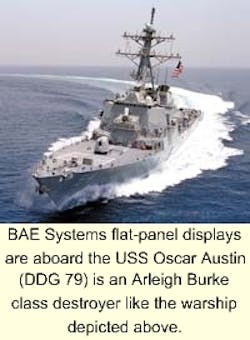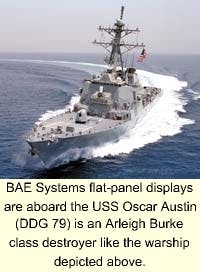Oscar Austin sails with BAE Systems displays and antenna
By John McHale
NASHUA, N.H. — The Navy's newest ship, the guided missile destroyer USS Oscar Austin (DDG 79), sets sail with new displays and an AIMS antenna from BAE Systems Information and Electronics Warfare Systems — formerly Sanders of Lockheed Martin — in Nashua, N.H.
AIMS stands for Air traffic control radar beacon system, identification friend or foe, MKXII, System.
The Austin was commissioned late this summer at the Norfolk Naval Station, Va. BAE flat panel displays. BAE has produced more than 600 color active matrix liquid crystal displays (AMLCDs) for the Aegis weapon system since 1997.
"The flat panel displays will be installed in 23 Aegis destroyers and several Aegis cruisers over the next two years, replacing the older cathode ray tube (CRT)-based displays," says Mike Leavitt, BAE program manager.
The new AMLCD panels provide Navy crews with an external status of the command-and-control features of the Aegis combat system. The 13-inch flat panel displays are currently deployed in the combat information center aboard Navy Burke-class destroyers.
The displays are capable of displaying anti-air, anti-surface, and anti-submarine warfare operations simultaneously. There are 12 flat panel displays on each ship.
The CRTs replaced were about 15 to 20 years old, Leavitt says. The new AMCLDs, which have 1,280-by-1,024-pixel resolution, basically fit into the same rack on the ship that the CRTs did, he adds. The actual contract with the Navy is about eight years old, Leavitt says. System life for the new displays should be about 15 to 20 years, he adds.
Leavitt says that the new flat-panel displays offer increased reliability, lower cost, and the ability — unlike the older CRTs — to work in a high-magnetic field environment.
Flat panels are inherently more immune to electromagnetic interference, or EMI, because they do not use an electron beam, Leavitt says. CRT displays, which have an electron beam, show distorted images when turned over on their sides and the electron beam gets out of synch with the earth's magnetic field, he explains. This is a problem that often occurs with airplanes, Leavitt adds.
The Navy is also experiencing dramatic cost savings by going to commercially based flat-panel displays, Leavitt says. The original CRTs probably cost about $100,000 apiece, while commercial flat panels are available off the shelf without ruggedization for less than $1,000, he adds.
For the AIMS program Leavitt and his engineers bought NEC commercial flat-panel displays, then took them apart and modified the devices for military specifications, he explains. The result is commercial technology with ruggedness and reliability, Leavitt adds.
The BAE electronics arm will not continue to manufacture the displays once the contract is finished, since there are now plenty of firms that specialize in rugged displays, Leavitt says. When the contract was first awarded there were few if any companies that could pull this off, he adds.
AIMS antenna group
BAE's OE-120/UPX AIMS antenna group for aircraft identification is a significant part of the AN/UPX-29 Interrogator System on many Navy platforms, BAE officials say. The system helps locate and identify aircraft as friend or foe.
The AIMS system includes a Litton processor, while the integrator is the BAE Systems arm, which was formerly Hazeltine, says BAE's Steve Dichard, AIMS program manager.
The prominent feature of the AIMS antenna group is 64 radiating elements of the antenna arrayed in a circle around the ship's mast. The AIMS antenna elements remain stationary while a beam is steered electronically to provide 360 degrees of coverage around the ship. An antenna position programmer receives commands from a below-deck control unit to control the antenna's beam mode and boresight direction.
The control unit processes the host system's digital or analog commands, continuously translates synchronized data from shipboard environmental sensors, and can modify its commands to the programmer to compensate for ship's heading, roll, and pitch. The antenna can operate in temperatures between -28 to 65 degrees Celsius, Dichard says.
The AIMS antenna is more efficient than the traditional rotating antenna formerly used by the Navy and currently in use at airports around the world, Dichard claims.
When a target is spotted with a rotating device the operator has to wait until the antenna completes a full rotation before he can get another fix, Dichard explains. The AIMS device enables the operator to go to any azimuth instantly through digital technology, he says. The antenna has 64 elements which can be accessed at any time by the controller, Dichard continues.
Many ships will still carry a rotating antenna as backup, in case it is destroyed in combat, but there are few failures electronically if any with the AIMS device, he says. The entire AIMS system has a mean time between failure (MTBF) of about 13,000 hours, while the antenna alone has an MTBF of about 19,000 hours, Dichard explains.
The AIMS antenna is on several classes of ships and two antennas may go aboard aircraft carriers, Dichard says.
The Oscar Austin, which is the Navy's first Flight IIA Burke-class Aegis destroyer, bears the name of Private First Class Oscar P. Austin, U.S. Marine Corps. Austin was killed Feb. 23, 1969, while saving the life of an injured companion, an action that earned him the nation's highest military award, the Congressional Medal of Honor.

